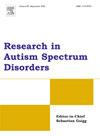自闭症幼儿儿童行为检查表的测量不变性
IF 2.2
4区 医学
Q1 EDUCATION, SPECIAL
引用次数: 0
摘要
背景人们已经对患有自闭症谱系障碍(ASD)的大龄儿童和青少年的挑战行为进行了研究,但对学步儿童的这些行为却知之甚少,部分原因在于测量方法的多变性以及适用于这一人群的工具有限。为了满足这一需求,本研究在一组患有自闭症谱系障碍(ASD)的幼儿中对儿童行为核对表(CBCL)的心理测量特性进行了研究,该核对表是一种常用的、经过广泛验证的挑战性行为测量方法。对CBCL的心理测量学进行了分析,包括内部一致性、因子结构和测量不变性。结果确认性因子分析结果表明,测试模型的拟合度可以接受,内部一致性基本可以接受。每个分量表的所有测量不变性水平都通过了测试。情绪反应、焦虑/抑郁、退缩和攻击行为分量表实现了标度不变性,而注意力问题分量表实现了度量不变性,躯体抱怨分量表甚至没有实现构型不变性。结论结果表明,目前自闭症幼儿挑战行为的CBCL概念与年龄较大的自闭症儿童的此类构型一致,并为使用CBCL评估ASD幼儿的挑战行为提供了初步支持。测量不变量(MI)分析支持 CBCL 在 ASD 幼儿中的构建有效性。不过,根据测量不变量分析的结果,在对患有和不患有 ASD 的幼儿进行分组比较分析时,需要对特定的子量表谨慎对待。本文章由计算机程序翻译,如有差异,请以英文原文为准。
Measurement invariance of the Child Behavior Checklist in autistic toddlers
Background
Challenging behavior has been examined in older children and adolescents with autism spectrum disorder (ASD), but less is known about these behaviors in toddlers, due in part to variability in measurement and limited instruments available for this population. To address this need, this study examined the psychometric properties of the Child Behavior Checklist (CBCL), a commonly used and widely validated measure of challenging behavior, in a group of toddlers with ASD.
Method
Participants included 496 toddlers aged 18–48 months with (n=398) and without (n= 100) a diagnosis of ASD. Psychometrics of the CBCL were analyzed including internal consistency, factor structure, and measurement invariance.
Results
Confirmatory factor analysis results indicated acceptable fit for the tested model, and internal consistency was largely acceptable. All levels of measurement invariance were tested for each subscale. The Emotional Reactivity, Anxious/Depressed, Withdrawn, and Aggressive Behavior subscales achieved scalar invariance, while the Attention Problems subscale achieved metric invariance, and the Somatic Complaints subscale did not achieve even configural invariance.
Conclusions
Results indicate the current CBCL conceptualization of challenging behavior in autistic toddlers is consistent with such constructs in older autistic children and provide preliminary support for the use of the CBCL to assess for challenging behavior in toddlers with ASD. Measurement invariance (MI) analyses support the construct validity of the CBCL in toddlers with ASD. However, based on the results of the MI analyses, some caution is warranted with specific subscales when conducting group comparison analyses between toddlers with and without ASD.
求助全文
通过发布文献求助,成功后即可免费获取论文全文。
去求助
来源期刊

Research in Autism Spectrum Disorders
Multiple-
CiteScore
4.20
自引率
8.00%
发文量
108
期刊介绍:
Research in Autism Spectrum Disorders (RASD) publishes high quality empirical articles and reviews that contribute to a better understanding of Autism Spectrum Disorders (ASD) at all levels of description; genetic, neurobiological, cognitive, and behavioral. The primary focus of the journal is to bridge the gap between basic research at these levels, and the practical questions and difficulties that are faced by individuals with ASD and their families, as well as carers, educators and clinicians. In addition, the journal encourages submissions on topics that remain under-researched in the field. We know shamefully little about the causes and consequences of the significant language and general intellectual impairments that characterize half of all individuals with ASD. We know even less about the challenges that women with ASD face and less still about the needs of individuals with ASD as they grow older. Medical and psychological co-morbidities and the complications they bring with them for the diagnosis and treatment of ASD represents another area of relatively little research. At RASD we are committed to promoting high-quality and rigorous research on all of these issues, and we look forward to receiving many excellent submissions.
 求助内容:
求助内容: 应助结果提醒方式:
应助结果提醒方式:


